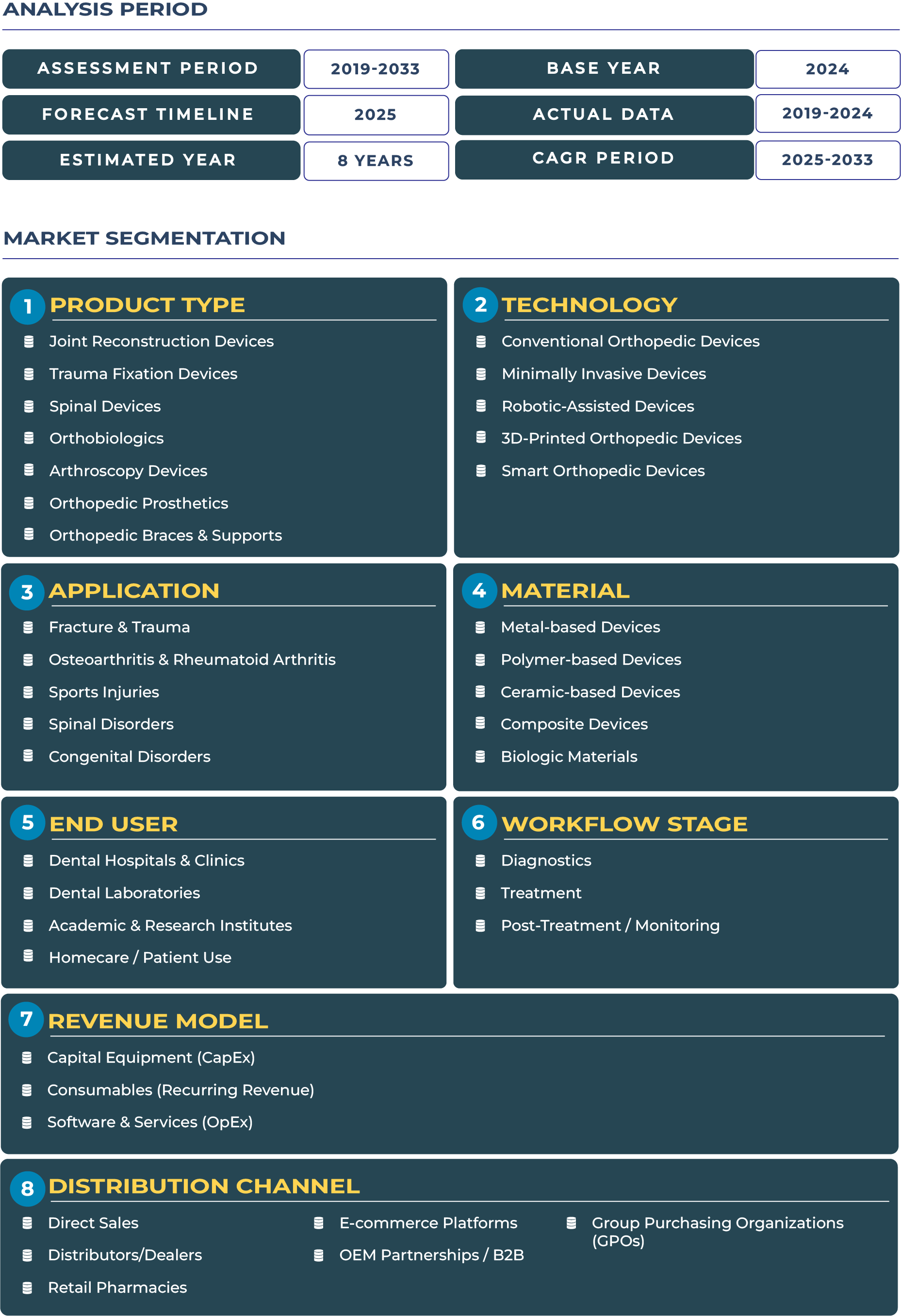Japan Orthopedic Devices Market Outlook: Advanced Robotics Meeting the Realities of a Super-Aging Society
Japan Orthopedic Devices market is defined by dual forces: its global leadership in advanced surgical robotics and its demographic challenge as one of the world’s oldest societies. The country has invested heavily in robotic-assisted orthopedic surgery systems, particularly in large hospitals across Tokyo and Osaka, where joint replacement procedures are increasingly performed with robotic precision. This demand stems from Japan’s super-aging population—nearly 30% of its citizens are aged over 65, according to the Statistics Bureau of Japan. As orthopedic conditions such as osteoarthritis and spinal degeneration become more prevalent, demand for implants, arthroscopy systems, and spinal devices has intensified. By 2025, the Japan orthopedic devices market is expected to reach USD 2.63 billion, growing to USD 3.12 billion by 2033. The relatively modest growth reflects both a mature demand base and government-led price containment policies. Nonetheless, Japan remains a key market for innovation, particularly in implant longevity, robotics integration, and outcome-driven care.
Robotics, Longevity, and Patient-Centered Care Defining the Future of Orthopedic Devices in Japan
The outlook for Japan Orthopedic Devices industry is strongly influenced by its aging demographics and high level of medical sophistication. Unlike emerging markets, Japan does not rely on sheer volume growth but instead on innovation, premium device differentiation, and precision care models. Government healthcare policy—coordinated through the Ministry of Health, Labour and Welfare (MHLW)—focuses on cost containment while ensuring universal access. This dual mandate creates an environment where providers emphasize the use of implants with proven long-term durability, particularly in hip and knee replacements.
Despite a relatively saturated demand, robotics and digital integration are advancing steadily, positioning Japan as a global leader in outcome-driven orthopedic care. The modest CAGR underscores a mature yet innovation-led market, with growth coming not from patient numbers but from advanced surgical techniques, premium prosthetics, and long-term rehabilitation solutions. These dynamics make Japan Orthopedic Devices landscape a reference point for high-value, sustainable healthcare delivery.
Drivers & Restraints: High Surgical Precision Meets Market Saturation Challenges
Growth Drivers: Japan exhibits one of the highest per-capita orthopedic surgery rates globally, with hip and knee replacements performed frequently among its elderly population. Strong reimbursement policies, coordinated through the national health insurance system, ensure accessibility for patients across rural and urban regions. Moreover, Japan’s medical workforce is highly specialized, with orthopedic surgeons extensively trained in advanced arthroscopy and robotic-assisted interventions. These factors collectively sustain robust demand for devices ranging from trauma fixation systems to spinal implants.
Restraints: However, growth is constrained by market saturation, with most demand already addressed by existing infrastructure and providers. Strict regulatory approvals under the Pharmaceuticals and Medical Devices Agency (PMDA) extend product launch timelines, adding hurdles for global manufacturers. Price containment initiatives, particularly in joint reconstruction implants, reduce margins and limit expansion opportunities. Together, these restraints emphasize a challenging business environment where innovation must be paired with cost efficiency and regulatory alignment.
Trends & Opportunities: Outpatient Growth, Implant Longevity, and Bundled Care Models
Emerging Trends: Japan is experiencing rapid penetration of ambulatory surgical centers (ASCs) in metropolitan hubs such as Tokyo and Nagoya. These centers emphasize minimally invasive procedures and same-day discharge, reshaping patient expectations. Furthermore, the orthopedic devices sector is increasingly focused on implant longevity and outcome-based metrics, as patients live longer and demand durable solutions. There is also a growing emphasis on conservative care and rehabilitation, where digital tools and wearable devices complement surgical interventions.
Opportunities: The orthopedic devices ecosystem in Japan presents opportunities for premium differentiated implants designed for extended longevity, especially in joint replacement. Global and domestic players are exploring service+device bundles, integrating aftercare support with implant sales. Long-term clinical outcome studies, particularly in collaboration with leading Japanese hospitals, provide a competitive edge by aligning product performance with evidence-based care. Regional expansion beyond Tier-1 cities also presents openings, particularly in prefectures with high elderly populations but fewer advanced care centers.
Competitive Landscape: Local Precision Meets Global Innovation in Orthopedic Devices
Japan Orthopedic Devices landscape is shaped by both domestic and international players. Local companies such as Japan Medical Dynamic Marketing maintain strong distribution networks and provide orthopedic trauma fixation and spinal devices suited for the domestic population. International leaders such as Stryker and Smith & Nephew are expanding robotics portfolios in Japan, leveraging partnerships with local hospitals to strengthen adoption. In 2024, Stryker announced the expansion of its robotic-assisted knee surgery platform into additional Japanese surgical centers, aligning with demand for outcome-driven care.
Strategic approaches in the market include differentiation through implant longevity, investing in local key opinion leader (KOL) trials, and introducing warranty models for premium implants. These strategies resonate with Japan’s patient population, which prioritizes reliability and outcomes over short-term affordability. The orthopedic devices sector in Japan, while slower-growing compared to emerging markets, represents one of the most advanced ecosystems globally, combining high clinical standards with precision-driven innovation.







